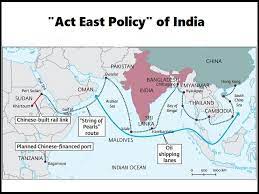19 Mar 2022 Act East Policy

- Recently a webinar was organized on “Act East Policy”.
About Act East Policy:
- India’s ‘Act East’ policy i.e. ‘Work East Policy’ is a ‘diplomatic initiative’ to promote economic, strategic and cultural ties with the wider Asia-Pacific region at various levels.
- It was introduced in 1991 by the then Prime Minister P.V. Narasimha Rao’s ‘Look East Policy’ i.e. ‘Look East Policy’ is considered to be the modern version.
- The “Act East Policy” was launched in November 2014 at the ‘East Asia Summit’ held in Myanmar.
- Under the “Act East Policy”, the Government of India emphasizes on the 3 C’s (Culture, Connectivity, and Commerce) to develop better relations with ASEAN countries.
Major difference between “Look East Policy” and “Act East Policy”:
- The “Look East Policy” focused on economic integration with the Association of Southeast Asian Nations (ASEAN), and the policy was limited to Southeast Asia only.
- The “Act East Policy”, on the other hand, focuses on economic integration of ASEAN countries and security cooperation with East Asian countries.
Objectives of ‘Act East Policy’:
- To promote economic cooperation, cultural ties and develop strategic ties with the countries of the Asia-Pacific region through continuous engagement at regional, bilateral and multilateral levels.
- To enhance the connectivity of North-East Indian states with other neighboring countries.
- According to experts- Government of India believes in 3 C’s i.e. Culture, Connectivity and Commerce, (3 C’s – Culture, Connectivity, and Commerce) to develop better relations with ASEAN countries under “Act East Policy”.
Importance:
- Under the Act East Policy (AEP), the ‘India-Japan Strategic Partnership’ has been taken to a whole new level, underscoring the importance of Indo-Pacific cooperation.
- India believes in a free, open and inclusive ‘Indo-Pacific’ founded on a cooperative and cooperative law-based order.
- ‘ASEAN centrality’ remains an enduring contemporary feature of ‘Indo-Pacific’ at the regional level.
- India has placed the ‘Indo-Pacific’ at the center of its contacts with countries in South, Southeast and East Asia. Gradually, the ‘Act East’ policy is turning into an ‘Act Indo-Pacific’ policy.


No Comments